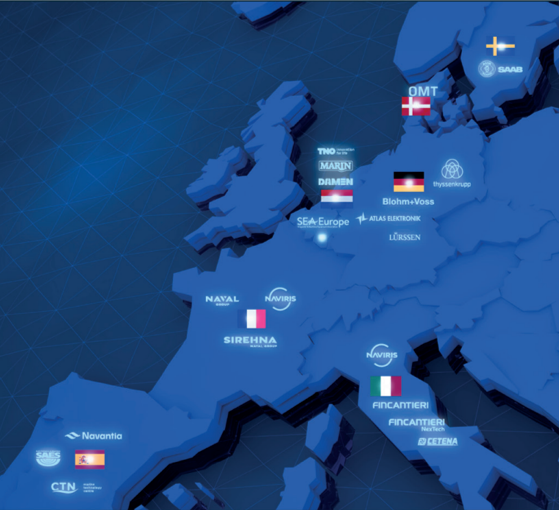To give a concrete view into the world of European defence industrial collaboration, we present the case study of SEA Defence. The SEA Defence project, part of the European Defence Industrial Development Programme, was launched in December 2020. As part of the EU’s strategy of strengthening the European defence technological and industrial base, in addition to increasing the EU’s autonomy, SEA Defence is a 30-month long feasibility study that has the aim of compiling a roadmap of technologies to be developed and introduced into next-generation naval platforms.
Inherent in SEA Defence’s existence is the philosophy of collaboration. To that end, the project partners include a broad selection of the big players in the European naval shipbuilding industry. Fincantieri (Italy), Naval Group (France), Navantia (Spain), SAAB Kockums (Sweden), and thyssenkrupp Marine Systems and Lürssen Defence (Germany) are all included in the project. Furthermore, the SEA Defence project is supported by participating EU Member States and knowledge institutions; Netherlands Ministry of Defence, TNO, and MARIN in the case of the Netherlands.
Damen Naval has the honour of coordinating the SEA Defence project, under the watchful eye of Project Manager Marcel Elenbaas. “SEA Defence is about the identification of defence technologies, both from the viewpoint of requirements as well as from the viewpoint of emerging technologies. At the same time, the project is about how the European naval shipyards can find a way to work together better.” And even though the project was initiated in the midst of the coronavirus pandemic, Marcel is pleased with the progress. “We didn’t actually meet each other in person for the first 18 months, but with a.o. TNO’s virtual sessions and a lot of creativity, all the work we have carried out so far has been approved by Member States and the European Commission.”
Changing times
While the project partners have traditionally had competitive relationships with each other (the aforementioned list of European shipbuilders look for work in the same export market), the SEA Defence project demonstrates that times have changed. “There is a definite need to strengthen both the European defence units – land, sea and air – and the European naval shipbuilding cluster. It is the desire that we cooperate to close EU Defence technological gaps and maximise its effectiveness through innovation and increased interoperability, for example. The situation in Ukraine has shown us the importance of a strong and collaborative Europe,” notes Marcel.
The SEA Defence project has identified seven areas of technology. “We are currently defining the trajectories of research into these technologies in a process in which the project partners, the member states, and the European Commission try to align themselves to the development of new capabilities.”

Technology areas
- Lower detectability: “This looks at subjects such as underwater sound emissions, infrared and radar cross section – all with the aim of ensuring that you are invisible to the enemy.”
- Higher survivability: “This ensures that a ship is in a better state to survive a hit from, for example, and enemy missile.”
- Enlarging operability: “Enabling a that a ship operates better in higher sea states, providing the possibility to launch or land unmanned vehicles. This subject includes deployability and replenishment at sea.”
- Electrification: “There are more and more high energy weapons which demand more from a ship’s electrical capabilities. But this includes the need to become more independent from fossil fuels in a way that is robust and safe enough for a naval ship.”
- Extreme climates: “Naval operations are moving towards more extreme heat and cold; vessels have to deal with ice as well as sandstorms.”
- Topside architecture: “This includes all the sensors and weapons systems, and how these are integrated into the overall Naval platform.”
- Automation and autonomy: “Navies need to become less dependent on people on board ships and the complexity of controlling platform, weapon and sensor systems require decision support or even fully autonomous systems. In the case of autonomous ships, you have to cooperate towards interoperable solutions because each ally’s systems have to communicate with each other’s.”
Building on the results
Considering the end date of the SEA Defence feasibility study is mid-2023, the goals are clear. “This project goes beyond the identification of new technologies that have to be developed and applied by shipyards, co-makers, suppliers and research infrastructure. It also supports and facilitates the cooperation and interaction among the member states on these topics. So, for example, if certain European navies intend to collaborate on specific capabilities, its national naval clusters can define further collaborations in those fields of technology. As such, SEA Defence forms a stepping stone in shaping the European Defence fund and its European naval collaborations.”
As for Damen Naval, Marcel explains there are clear ambitions. “We want to have defined a number of future key technologies, for Damen and of course the Netherlands Navy. In our role as integrator, we keep on strengthening our ability to create the best integrated Naval platform in cooperation with our trusted partners in the maritime cluster in the Netherlands and beyond,” says Marcel. “Within SEA Defence, we aim to extend our integrators role with international cooperation in these key development areas.”
Damen Naval will be attending the EURONAVAL naval defence exhibition in Paris from 18-22 October, also with a dedicated booth for SEA Defence. Together with Capt. Paul Flos (RNLN), Damen will be giving a keynote speech during the exhibition detailing the progress of the SEA Defence project.